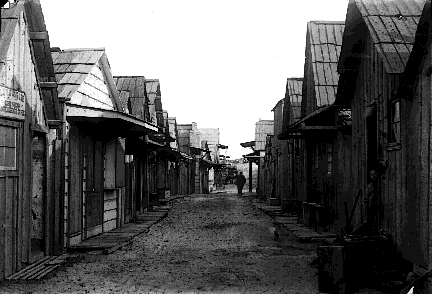by Jonathan Kemp
As was true of many early California communities, hard working Chinese immigrants played a major role in the development of Monterey and especially of the Cannery Row area.
Chinese fishermen were the first to mine the rich marine treasures of Monterey Bay, and their industrious efforts as early as the 1850s helped make Monterey one of California’s most successful fishing ports. The story of Chinese settlers of Cannery Row is a tale of both success and sorrow–hard work tempered by suspicion, fire, and cultural conflict.
While virtually no physical evidence remains of the early Chinese settlements on Monterey Bay, visitors can still see a strong reflection of our community’s rich Chinese heritage.
Although historical accounts differ, a popular legend has it that our area’s first Chinese inhabitants set up camp in 1851 on the cove of Point Lobos, some miles to the south of Cannery Row. Upon discovering the rich bounty of Monterey Bay, these experienced fishermen soon established additional Chinese settlements at Pescadero (now Stillwater Cove, just west of Pebble Beach on Carmel Bay) and at Point Alones near what is today the bustling tourism center of Cannery Row.
By 1853 there were some 500 to 600 Chinese fishermen working the deep waters off Monterey. The Chinese community had become well enough established that Cabrillo Point, the site of today’s Hopkins Marine Station at the north of Cannery Row became known as China Point.
These skilled Chinese seamen launched the first commercial fishing industry in Monterey, taking first abalone and later other varieties of fish including cod, halibut, flounder, yellowtail, sardines, squid and shark–as well as oysters and mussels from the bay waters. It was a common sight to see the unique Chinese fishing boats setting off from the shanty-like village at “China Point.”

And the smell of drying fish was an ironic and aromatic portent of the future success of one of California’s most colorful port cities. Entire Oriental families worked side by side employing fish traps, gill nets and seines to reap their bountiful harvest.
By 1900, some 200 to 800 pounds of fresh catch were sent daily to the busy fishmongers on Clay Street in San Francisco. The Chinese also produced a fortune in dried fish; abalone meats and shark fins. Some of this dried product found its way to the bustling mines of the Sierra Nevada mountains, but much of it was destined for shipment directly to the immigrants’ home province of Canton, China.
An impressive sight in those early days of Cannery Row was the arrival of large, ocean-going Chinese junks with their massive lanteen sails. These splendid craft would anchor off China Point, where they would unload Oriental goods for the local Chinese, then load their holds with dried squid–a food staple and fertilizer much sought after in China.
Indeed, the Chinese fishermen were so successful that serious conflict developed with Italian-American fishermen who began to work the waters of Monterey Bay in the later 1800s. This conflict further contributed to the tension and prejudice against Monterey’s Chinese fishing community.
Robert Louis Stevenson, who spent four months on the Monterey Peninsula in 1879, wrote of his vivid impressions of the area’s well established Oriental communities:
‘”And yet the boats that ride in the haven are of strange and outlandish design; and, if you walk into the hamlet you will behold costumes and faces that are unfamiliar to the memory. The joss-stick (incense) burns, the opium pipe is smoked; the floors are strewn with strips of colored paper–prayers, you would say that somehow missed their destination–and a man guiding his upright pencil from right to left across the sheet, writes home the news of Monterey to the Celestial Empire.” Stevenson’s fascination with the Chinese was similar to many American’s who were without experience with things Asian, especially its people.
Like many typical fishing villages in China, the China Point settlement was built virtually on the shoreline and many of the village’s stilted shanties literally overhung the rocky shore of the bay. The settlement consisted of numerous rough structures gathered around a single street. The village’s flat-bottomed fishing boats were either beached or tied up at the owner’s back door.
Visitors could usually smell the village before they could see it. Poles and ropes were hung with all manner of sun-drying fish, while nearby fields were used to spread and dry the highly aromatic squid. It seemed that every resident of China Point–man, woman and child–was employed in catching, cleaning or processing the bounty of the deep. China Point brought to Monterey much of the romance and mystery of the Orient. The Joss House, or shrine, was an essential part of Chinese life and the site of a daily ritual for fishermen. Decorated with ornate carvings and bathed in incense, the Joss House was the most dominant and substantial structure built on all of China Point. Because of its distance from the main settlement the Joss House survived a tragic fire in 1906 which completely devastated Monterey’s original Chinese settlement. When the burned-out Chinese leased a new village site at McAbee Beach, near the center of what is now Cannery Row, the Joss House was moved to the new but smaller settlement within the city limits of Monterey. In the late 1920s the Joss House was moved again, this time to share a narrow hillside lot on Wave Street with another of Cannery Row’s most famous structures, the “Palace Flophouse” of John Steinbeck’s “Cannery Row.”
New Monterey’s Chinatown also boasted a less desirable fixture of many Chinese communities–the opium den. Operated openly and tolerated by local authorities, the opium den featured the traditional tiers of bunks where addicts took deep breaths of opium smoke from long stemmed pipes. A jar of opium could be had for as little as ten cents in those days, and it was not unusual to find any number of smokers lying in a dream-like stupor.
Perhaps the most colorful aspect of the Chinese community was the noisy and joyous traditional New Years celebration. Marked by dragons and street parades, firecrackers and feasts, the Chinese New Year was also a time of celebration for the area’s non-Oriental communities. The Chinese offered trays of nuts, candies and firecrackers to all comers, and the ongoing party was not unlike those still seen in today’s thriving Chinese enclaves of San Francisco and Los Angeles.
Unfortunately, growing competition for fishery resources on the increasingly crowded waters of Monterey Bay–worsened by the cultural biases and anti-Chinese laws of the later 1800s–did not bode well for the future of Monterey’s Chinese community.
California offered at best a grudging welcome to Chinese immigrants, and Monterey was no exception. Brought by the thousands to the mines and rail heads of the Golden State, the Chinese were looked upon with suspicion and disdain by the increasingly dominate European Americans.
It was the competition between Chinese and emigrating European fishermen, particularly Italians, which led to the growth of the squid into a major product of Monterey Bay waters. As the Italian fishing community gained primacy on the Bay and at the dockside, the resourceful Chinese took increasingly to the taking of squid my night fishing–when there operations did not conflict directly with those of the Italian crews. Fishing at night, the Chinese used torches and pitchwood burned in wire baskets hung from the sampans to attract the curious squid to their nets. New laws passed between 1875 and 1900 greatly restricted the ability of Chinese to fish and process or sell their catch.
Newspapers and citizens sided clearly with the non-Chinese fishermen and laborers, and some called openly for the removal of the China Point settlement. On the night of May 16, 1906, a disastrous fire of suspicious origin swept through the Chinese quarter destroying virtually every major structure expect the Joss House. Although the origin of the fire was never determined, and some non-Chinese fought valiantly to stop the flames, the fire was the final calamity for China Point. Local regulations were quickly established prohibiting the rebuilding of the Chinese settlement at its original site. Some Chinese then relocated to McAbee Beach or dispersed to other Oriental settlements–but the Chinese fishing presence on Monterey Bay never fully recovered.
Yet the determined Chinese were destined to play yet another remarkable role in our local history, in the rise of Cannery Row to international status in fish canning. When the sardine factories were eventually established on Cannery Row, many of the skilled early workers were descendants of China Point’s original Chinese fishermen.
Today, Chinese-Americans are a thriving and successful part of the California community. But in Monterey special recognition is due its Chinese community to commemorate the toil, skills and contributions to the growth of its world-famous fishing and canning industry. An industry really begun by fishing families at Cannery Row’s “China Point.”
Source:
- Cannery Row Historic Newspaper, Winter/Spring 1995-1996 (copyright 1995 by the Cannery Row Marketing Council; used with permission).
For additional information:
- Lydon, Sandy, Chinese Gold: The Chinese in the Monterey Bay Region (Capitola Book Co., Capitola, CA 1985).


